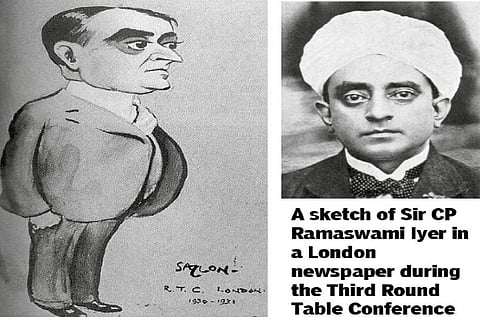

Chennai
SOMERSET Maugham — probably the most highest-paid author during the interwar period — would at the peak of his career write a novel The Narrow Corner which had an Indian character. Obviously, named after a man who impressed the author. It was CP Ramaswamy Iyer.
For a couple of pre-freedom decades, CP Ramaswamy Iyer was the most powerful man from Madras reserving a permanent place for him in the daily newspapers. Though most of them were for his far-reaching reforms, it also has to be said very few Madras-born have courted controversy as CP would.
CP lived in the huge corner property owned by his father, a prosperous lawyer, on the Eldams Road in Alwarpet, just a mile from the huge Mambalam lake. The house, when British owned, was called ‘The Baobab’, which is a tree native only to the isle of Madagascar. There are three known surviving samples in Madras and though there is not one in this compound, it probably had for it was named after the tree. Studying in Madras and enlisting in the Bar, he represented in court wealthy clients including the Nizam of Hyderabad, the maharajah of Kashmir and built a personal fortune.
CP as a lawyer appeared in court on behalf of Jiddu Narayaniah against Annie Besant for the custody of his philosopher son J Krishnamurti in the famous trial and won. The case and court proceedings were acrimonious, but CP would become great friends with Annie and was involved in organising the Home Rule League with her and finally unveiled her statue (the first public statue in Marina).
It was CP who edited New India during Besant’s incarceration in Ooty over her anti-British writing. Sedition at that time was punishable with confiscation of the building from which it was propagated. Worldly smart CP would hang the board of the newspaper on a tree in his garden and edit the paper seated in its shade.
His political career in the Congress would go up and down with that of Besant. At one point, he was one of the two joint secretaries of Congress. The other rose to be the first prime minister. With the onset of Gandhian supremacy in the party, CP would leave the Congress once and for all.
It shocked many when like a pendulum, CP would swing to the other side and associate himself firmly with the British establishment. He became the youngest Advocate-General of the Madras Presidency and later Law Member of the Governor’s Executive Council, Madras. He was the Indian Delegate at the League of Nations in Geneva and attended the Third Round table conference as well.
CP was made a Knight Commander of the Indian Empire in 1926 and a Knight Commander of the Star of India in 1941. He relinquished these on independence. His powerful friends (Governor and later Viceroy, Willingdon and the Queen mother of Travancore amongst them) shot CP to the forefront of politics.
He would actively involve himself in the family politics of the Travancore royal family and for some time the royal pieces were but pawns in CP’s political chess.
Travancore had a powerless boy-king Chitra Tirunal and CP’s influence had the Regency terminated and the king invested with all reigning powers. CP became the rajah’s Legal and Constitutional Adviser. Coincidentally the underground treasure vaults of the Padmanabaswamy temple were opened the same year, setting off a long stream of rumours.
His achievements as diwan in Travancore were on either end of the spectrum. Far-reaching reforms in society (Gandhi praised his temple for all proclamation), industry, irrigation and power generation were coupled with his merciless handling of freedom and communist movements. The grateful maharajah would give him the title of Sachivottama meaning supreme counsellor.
When the Quit India movement threatened to engulf the country, CP Ramaswami was persuaded to move to Madras as a member for information in the Viceroy’s council. He shut the press up with a force that even the British were surprised. On the withdrawal of the British from India, to the shock of the entire nation, Travancore decided to become independent. CP established contact with a caucus of British MPs and Jinnah as well. He held a couple of press conferences in Trivandrum to justify independence and attacked Nehru with no holds barred. The freshly formed Indian union prepared to take Trivandrum by force, and rumours of the proposed bombing of the state abounded.
On 25 July 1947, CP exited the Trivandrum Music Academy after attending a Carnatic concert. The lights conveniently went off and an assailant KCS Mani slashed at the diwan with a large knife (the budget allotted for the assassination of CP was Rs 10 when even a stolen revolver cost Rs 1,000). Escaping with injuries, CP resigned as Dewan and drove to Ootacamund, where he had a colonial bungalow.
After Independence, he was actively involved in education, simultaneously being Vice-Chancellor of Annamalai and Benares Hindu Universities. In Annamalai varsity, he would hold the poets, essayists and novelists conference and estranged Nehru would reconcile with him there.
In January 1962, Nehru, rattled by the secession demand of the DMK, convened the National Integration Council and decided to set up a committee to counter regionalism. Nehru, in a masterstroke that surprised everyone, asked CP to head it. After all, his call for independence of Travancore was only 15 years old.
People who made similar calls in Hyderabad state were still in jail. But it worked. CP recommended the Sixteenth Amendment of the Constitution which made mandatory an oath of allegiance to get elected to parliament. DMK on an ascendant in the political landscape would prefer to avoid a showdown and drop the separation demand. In a way, CP had set his career record straight.
— The writer is a historian and an author
Visit news.dtnext.in to explore our interactive epaper!
Download the DT Next app for more exciting features!
Click here for iOS
Click here for Android